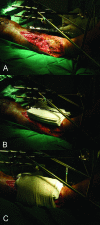LCP external fixation--external application of an internal fixator: two cases and a review of the literature
- PMID: 20302664
- PMCID: PMC2847991
- DOI: 10.1186/1749-799X-5-19
LCP external fixation--external application of an internal fixator: two cases and a review of the literature
Abstract
The locking compression plate (LCP) is an angle-stable fixator intended for intracorporeal application. In selected cases, it can be applied externally in an extracorporeal location to function as a monolateral external fixator. We describe one patient with Schatzker V tibial plateau fracture and one patient with Gustillo IIIB open tibia shaft fracture treated initially with traditional external fixation for whom exchange fixation with externally applied LCPs was performed. The first case went on to bony union while the second case required bone grafting for delayed union. Both patients found that the LCP external fixators facilitated mobilization and were more manageable and aesthetically acceptable than traditional bar-Schanz pin fixators.
Figures



Similar articles
-
Externalised locking compression plate as an alternative to the unilateral external fixator: a biomechanical comparative study of axial and torsional stiffness.Bone Joint Res. 2017 Apr;6(4):216-223. doi: 10.1302/2046-3758.64.2000470. Bone Joint Res. 2017. PMID: 28420623 Free PMC article.
-
[Long-term results of calcaneal fracture treatment by open reduction and internal fixation using a calcaneal locking compression plate from an extended lateral approach].Acta Chir Orthop Traumatol Cech. 2008 Dec;75(6):457-64. Acta Chir Orthop Traumatol Cech. 2008. PMID: 19150004 Czech.
-
Stiffness of the locking compression plate as an external fixator for treating distal tibial fractures: a biomechanics study.BMC Musculoskelet Disord. 2017 Jan 19;18(1):26. doi: 10.1186/s12891-016-1384-1. BMC Musculoskelet Disord. 2017. PMID: 28103852 Free PMC article.
-
General principles for the clinical use of the LCP.Injury. 2003 Nov;34 Suppl 2:B31-42. doi: 10.1016/j.injury.2003.09.023. Injury. 2003. PMID: 14580984 Review.
-
Clinical study of a new design multifunction dynamic external fixator system for open tibial fracture.J Med Assoc Thai. 2011 Sep;94(9):1084-8. J Med Assoc Thai. 2011. PMID: 21970197
Cited by
-
Management of Complex Open Tibial Plateau Fracture: A Case Report on the Application of Locked Plate External Fixation Technique during Bone Callus Formation stage to Replace transarticular External Fixation.Orthop Rev (Pavia). 2024 Mar 1;16:94035. doi: 10.52965/001c.94035. eCollection 2024. Orthop Rev (Pavia). 2024. PMID: 38435437 Free PMC article.
-
External fixation using locking plate in distal tibial fracture: a finite element analysis.Eur J Orthop Surg Traumatol. 2015 Aug;25(6):1099-104. doi: 10.1007/s00590-015-1604-7. Epub 2015 Feb 21. Eur J Orthop Surg Traumatol. 2015. PMID: 25697487
-
Externalised locking compression plate as an alternative to the unilateral external fixator: a biomechanical comparative study of axial and torsional stiffness.Bone Joint Res. 2017 Apr;6(4):216-223. doi: 10.1302/2046-3758.64.2000470. Bone Joint Res. 2017. PMID: 28420623 Free PMC article.
-
Staged treatment of proximal tibial fracture using external locking compression plate.Orthop Surg. 2014 May;6(2):154-7. doi: 10.1111/os.12101. Orthop Surg. 2014. PMID: 24890298 Free PMC article.
-
Non‑contact locking plate: A useful alternative to external fixation in second‑stage treatment of post‑traumatic tibial osteomyelitis.Exp Ther Med. 2024 Mar 26;27(5):230. doi: 10.3892/etm.2024.12518. eCollection 2024 May. Exp Ther Med. 2024. PMID: 38596657 Free PMC article.
References
LinkOut - more resources
Full Text Sources

